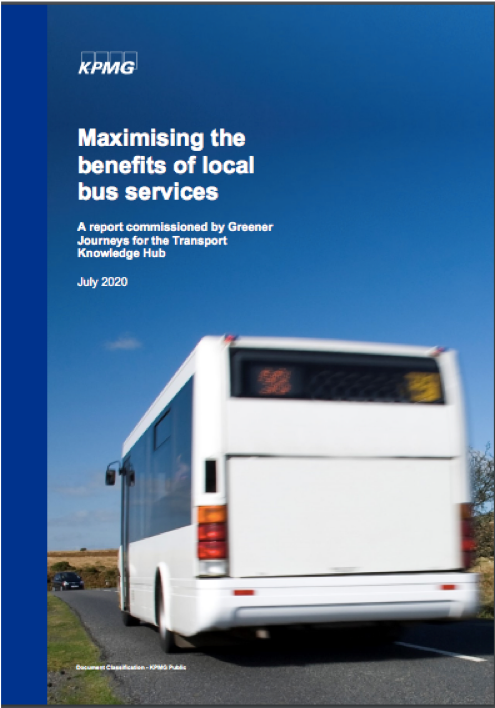In February 2020, the Department for Transport announced £5 billion of new funding over the next five years for bus services and cycling. Of this total, £2 billion has been allocated to 'active travel' and £3 billion to buses. A key question for the Government is how to allocate the new funding for buses in order to maximise wider economic, social and environmental benefits.
There are two important contextual considerations influencing this choice:
- Firstly, the Government has set a target of net zero carbon emissions by 2050. As at 2018, the transport sector accounted for 28% of all greenhouse gas emissions in the UK. Decarbonising the transport sector through the introduction of clean technologies and more efficient use of resources is therefore a policy imperative.
- Secondly, prior to the COVID-19 crisis bus use in Britain was falling at a rate of between 1% and 1.5% per year. During the initial phases of the COVID-19 crisis, bus use fell to less than 20% of pre-crisis levels. Whilst there has been some increase in passenger numbers as the lockdown has eased, there is significant uncertainty surrounding the shape and speed of patronage recovery. Both operators and local authorities anticipate some longer lasting changes to passenger behaviour.
Going forwards, once demand has recovered to a new steady state, there will be little benefit in investing in zero-emission vehicles if the vehicles become stuck in traffic and are not fully utilised. Whilst new vehicles will support decarbonisation, they will do little in themselves to increase patronage. To do this we will need to improve fares, frequencies, journey times and service reliability. This in turn will help to improve the financial sustainability of local bus networks, creating an environment which supports capital investment in infrastructure and vehicles.
Of the £3 billion of new funding for buses, the Department for Transport has suggested an initial allocation of funding of £1 billion of the funding to support investment in 4,000 zero-emission vehicles. In a new report commissioned by Greener Journeys for the Transport Knowledge Hub, we explore how the remaining £2 billion could be used to transform services in England outside of London. The analysis considers the balance of capital and revenue expenditure, and the allocation of funding between local authority areas.
There are of course different ways that this funding could be allocated. In our analysis, we adopt an approach based on the economic principles of efficiency and equity, pursuing twin objectives to maximise growth in passenger journeys for each £1 of new investment and levelling-up services to allow each local area to reach its potential in terms of patronage per capita.
To begin, we developed a set of econometric models to compare levels of bus use between local authority areas across Britain. The models allow us to benchmark observed levels of demand in each local authority area against levels of demand that we would expect to see given the socio-economic characteristics of those areas. Through this benchmarking exercise, we identify a 'patronage frontier' which includes local authority areas with the highest bus use per capita, after making an allowance for differences in the socio-economic characteristics between areas. This 'frontier' shows the level of patronage that is achievable with the right investment and market conditions.
We then determined the right investment package for different area types, drawing on evidence from a series of value for money studies of capital and revenue expenditure on local bus services, together with evidence from case study analysis of local authority areas (Bristol, Hull and Cornwall) which according to our benchmarking work outperform comparable areas in terms of bus patronage per capita. In addition to providing a benefit-cost ratio for each investment package, the analysis provides evidence on typical levels of patronage growth per £1 invested.
Armed with estimates of the size of the patronage gap between observed demand and the 'patronage frontier', together with information on typical levels of patronage growth per £1 of investment, we estimate that the efficient allocation of £1.5 billion of capital and revenue expenditure would generate enough demand to 'level-up' patronage levels between areas. This would enable all local authority areas to reach patronage levels currently only observed in the best performing areas - after taking account of the socio-economic characteristics of each area.
An additional £500 million of investment, would enable those local areas that are currently performing well in terms of their patronage per capita to grow demand further, shifting the 'patronage frontier' to new levels.
Taken together, investment to 'level-up' patronage in underperforming areas and 'shift the patronage frontier' in high performing areas would generate 425 million new bus journeys per year in England outside of London by 2024/25. Importantly, all local authority areas in England outside of London could expect to see at least a 20% increase in patronage.
Our analysis suggests that this would involve allocating 44% of the £2 billion for transforming services to metropolitan areas, 44% to urban and semi-urban areas and 12% to rural areas. The investment mix between capital and revenue will vary between areas and will be influenced by the speed and shape of the recovery to COVID-19. That said, achieving a balance between economic efficiency and equity would mean that on average between 60% and 70% of the £2 billion would be spent on infrastructure and between 30% and 40% on supporting fares and additional services.
It is important to note that within these broad scenarios, the Department for Transport will need to ramp-down the special payments to operators to run services during the COVID-19 crisis and ramp-up funding to local authorities to pay for an expected increase in 'supported services' before the benefits of capital investment in new infrastructure and vehicles take hold. In so doing, the funding will help to retain vital services through the recovery and provide a platform for the financial sustainability of the sector.
Given the importance of good public transport networks to local communities, the focus of operators, local authorities and central government will be on making the right investments in the short and medium terms to support decarbonisation, improve economic connectivity and social accessibility and strengthen the financial sustainability of the sector. The new National Bus Strategy will provide an ideal opportunity to plan how to do this. There is clearly a challenge ahead for the DfT in developing its investment strategy. It must find a way to manage the tension between efficiency and equity, making sure that it gets the best return on investment whilst at the same time making sure that no place is left behind. The analysis in our new report provides a guide to at least one way to do this.
Gerard Whelan is director of corporate finance, government and infrastructure at KPMG in the UK.




